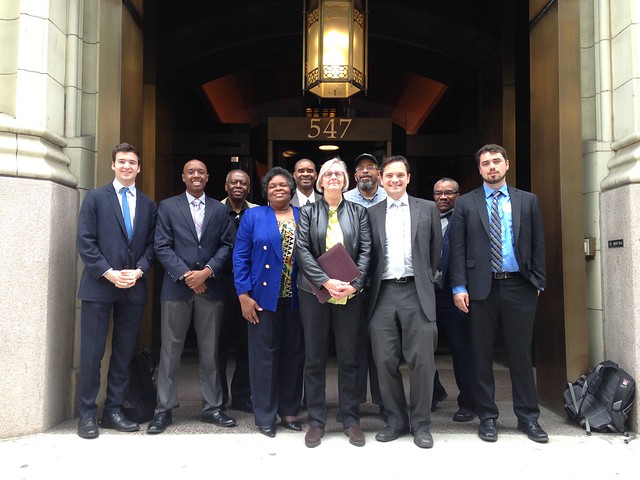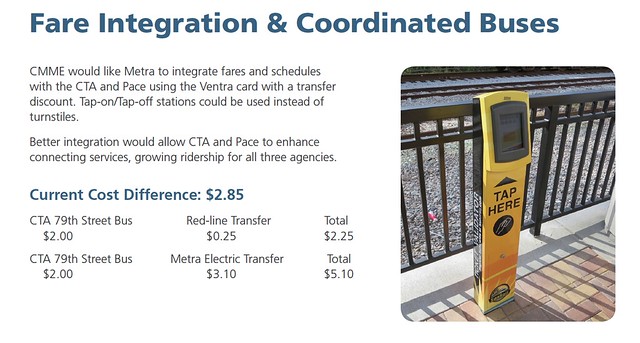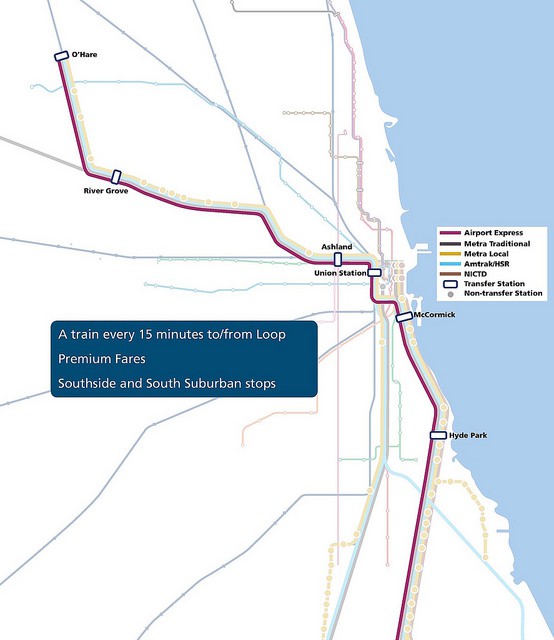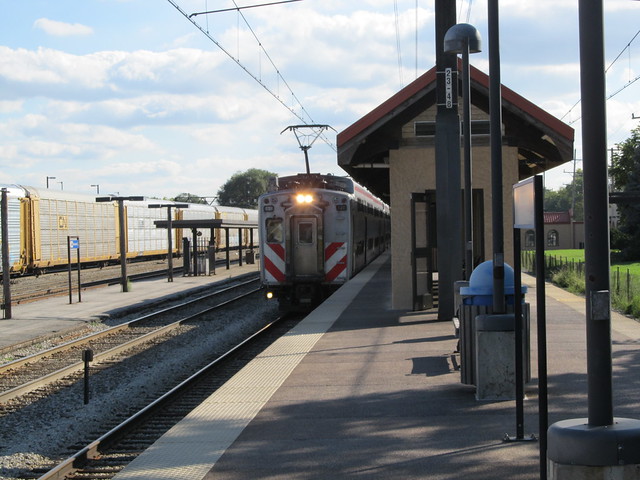
Transportation advocacy organizations and community groups have joined forces as the Coalition for a Modern Metra Electric, pushing for improvements to the commuter rail line that could lead to better job access and more economic development on the South Side. They want to see rapid transit-style train frequency, fare and schedule integration with the CTA and Pace, and – eventually – the extension of the line all the way to O’Hare.
Right now Metra generally runs trains only once an hour on the Metra Electric District line, which goes about 30 miles from Millennium Station to south suburban University Park, with a few more trains running during the morning and evening rush hours. As such, it’s not nearly as useful as an ‘L’ line for general travel, and it’s not a great option for non-standard work commutes.
However, it wasn’t always that way. The MED started its life as a rapid transit line with dedicated tracks and closed stations. The Coalition for a Modern Metra Electric wants to go back to the future, so to speak, by bringing back frequent service, with trains every 10-15 minutes, all day long.
Nowadays, if you need to ride downtown from the south suburbs or Southeast Side via the Metra Electric and continue on to a workplace on another side of the city, you need to pay the Metra fare, which is higher than the $2.25 charge for an ‘L’ ride, and then pay full fare for another train ride. Unlike riding on the CTA with a Ventra card, you don’t get a free transfer. As a result, some South Side residents choose to take a CTA bus to an ‘L’ line for their commute because it’s cheaper, even if the MED would be quicker.

The coalition wants to fix that problem by piloting tap-on and tap-off use of Ventra on the MED. This would allow customers to tap their Ventra card on a sensor before and after their ride, with the appropriate fare deducted according to the distance traveled. It would make it possible to provide a transfer discount for customers switch to the CTA or Pace.
In the long run, the coalition wants to see the MED connected to O’Hare Airport using Metra right-of-way, with stops at McCormick Place and Union Station, a scenario the Midwest High Speed Rail Association has proposed as part of its CrossRail plan to build a regional network of fast trains.
Mayor Emanuel wants to establish an express train between O’Hare and the Loop, so the MED solution would be a way to do this while creating better transportation access for residents of low-to-moderate-income communities on the South Side. That way the O’Hare Express wouldn’t just be a train for elites, and there would be the added benefit of direct access from the airport to conventions at McCormick Place for business travelers.
The idea of rapid transit on the Metra Electric has been around for decades. In the Nineties, rail advocate Mike Payne proposed having the CTA take over the MED, a scheme he called the Gray Line. In the 2000s, residents proposed a similar idea dubbed the Gold Line to provide frequent transit service to the Southeast Side as part of Chicago’s bid for the 2016 Olympics.

Although we lost the Olympics to Rio de Janeiro (and judging from current developments in that city, perhaps that was a good thing), the Gold Line proposal eventually led to the creation of the Coalition for a Modern Metra Electric. CMME currently includes the high speed rail association, the Active Transportation Alliance, the Center for Neighborhood Technology, and seven Southeast Side community groups.
The coalition testified about their proposals at a Metra board meeting last week. Linda Thisted from Hyde Park-Kenwood’s Coalition for Equitable Community Development, who helped found CMME and serves as its spokeswoman, addressed the board.
Thisted noted that most of Chicagoland’s job growth is on the North and Northwest Sides, so more frequent MED service would give South Siders better access to these jobs. She added that the improved rail service would also connect businesses with more customers, encouraging economic investment, and it would make the Southeast Side and south suburbs much more appealing to new residents.
Thisted called on Metra to look into the cost and feasibility of a tap-on/tap-off payment system, model the possible effects of transfer discounts between the three local transportation systems, and estimate the capital and operational costs of running frequent train service on the MED’s main line and two branches.
“[The Metra board] seemed to be listening,” Thisted told me afterward. “What it always comes down to is where the money’s going to come from, and that’s where the elected officials come in.” CMME has sent letters to all of the state senators, state reps, and aldermen along the line to help build support and find funding. “We’re in the process of scheduling meetings with them because, frankly, they’re the ones that can get the money.”
With our city and state governments in dire economic straits, isn’t this a tough time to be asking for cash? “Yeah, but you’ve got to take the long view,” Thisted said. “Nothing in transit is fast. It’s not going to happen this year, but we’ve got to get things started.”

Andrea Reed, director of the Greater Roseland Chamber of Commerce, a coalition member, said the time is right for better transit access to her community. “With the designation of Pullman as a national monument, the 115th and Kensington station is going to become a destination stop,” she said. “We’re looking to host over 300,000 tourists a year. The station itself needs some work but it’s an ideal location because there’s space for retail – it would be great if there was a coffee shop there.”
Reed noted that more frequent train service would make it easier for Roseland residents who are seeking jobs outside of the community. “Currently they may be able to get to the job, but they may not be able to get home easily because the [more frequent rush-hour] service is cut off at a certain time,” she said. “So it would be great to have more transportation choices for our community.”
Walt Kindred, a CMME member who’s a professional musician as well as an investor in a project to build a supermarket in a West Side food desert, said improving Metra access to the Southeast Side could encourage more people from outside the area to spend money there. He noted that recent concerts at the South Shore Cultural Center brought hundreds of people to the neighborhood, but many of them drove or took buses there, seemingly unaware that there’s a Metra station across the street from the venue. The fact that people coming from other sides of town would have had to pay a double fare in order to take Metra there may have also served as a deterrent.
Improving MED frequency and creating a transfer discount would encourage more people to ride the train to South Shore, Kindred said. “If you have more people coming to the area, businesses want to be there, which means more jobs and less crime,” Kindred said. “So one thing feeds off the other. It just makes so much sense to me.”
![]()
Did you appreciate this post? Streetsblog Chicago is currently funded until June 2016. Consider making a donation through our PublicGood site to help us win a $25K challenge grant that will ensure we can continue to publish next year.



